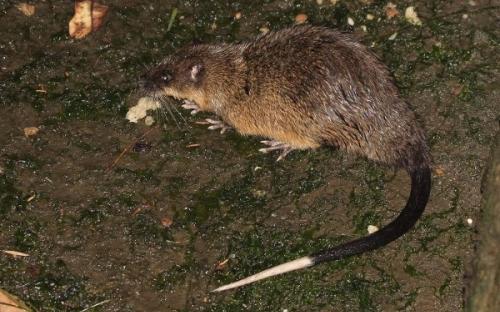Conservation status: Secure, of Least Concern. Threatened in Western Australia.
The rakali, also known as the ‘water rat’, is a large, semi-aquatic rodent native to Australia, and found in all states and territories, including throughout Victoria and in our own Bayside area.
Rakali are one of Australia’s only two semi-aquatic mammals, the other being the platypus. They are Australia’s largest rodent species and are sometimes affectionately referred to as ‘Australia’s otter’.
The rakali has a long streamlined body, with water repellent fur, a thick muscular tail, a broad face with long whiskers, small rounded ears, and partially webbed hind feet. They are typically a dark grey, brown or black in colour, with a lighter belly ranging from white to gold or orange, and a distinctive white tipped tail. They can grow up to 70cm in length from nose to tip of the tail, and weigh a little over a kilogram (about the size of an adult platypus).
Diet
The rakali are nocturnal hunters, mainly preying on small fish, crustaceans, molluscs and water bugs. However they have also been known to eat frogs, small water birds, bird eggs and even other small mammals.
Rakali have the rare ability to be able to kill and eat the introduced cane toads that are invading the tropics of Australia — they flip the toads over to avoid the poisonous glands found on the back of the neck.
Habitat
Suited to both saltwater and freshwater environments, rakali are found throughout Australia, where they make their homes in burrows along the low banks of rivers, lakes, wetlands and along the coast. They have adapted well to urban areas. They are both territorial and largely solitary animals, each typically occupying a 1-4 kilometre range of waterways.
Where to see rakali in and around Bayside
Rakali have been spotted at:
- Sandringham breakwater
- Brighton Pier
- Elsternwick Park
- Elwood Canal
- St Kilda Harbour
- Albert Park Lake
- Port Melbourne foreshore
The best time to observe rakali is a little before sunset, along the edges of waterways. You may also spot the telltale V-shaped wake as they swim. By using a a torch with a red light filter (or just by affixing red cellophane to a torch) you can observe them as it gets dark and they begin their evening hunting. As with many mammals, the rakali are unable to register the red colour, so they are not disturbed by the light.
To the untrained eye, it may be difficult to tell the difference between rakali and other pest rodents, such as the invasive Brown Rat and Black Rat. Rakali are generally a lot bigger than pest rats, and have a golden underbelly. But the easiest way to identify them is by their white tipped tails.
Threats
Just like many of our other native species, rakali are threatened largely by habitat degradation and loss, and predation by introduced species like foxes and cats. They can be trapped and killed by people who mistake them for pest rats.
During the 1930s and 40s, rakali were also widely hunted for their soft, waterproof furs, which were made into coats and hats. During this time they were almost hunted into extinction. Thankfully the hunting of rakali was banned in the 1950s.
Did you know?
A rakali female will produce only four or five litters of 3-4 pups, over her life span of around 3-4 years. By comparison, a common pest rat breeds prolifically, typically producing six litters a year consisting of 5-10 pups, over her lifespan of 2-3 years.
‘Water Rat’ was once the rakali's common name, however the negative association with pest rats led to their indiscriminate killing. In the 1990s, the Australian Nature Conservation Agency (now Parks Australia) phased out the old name, replacing it with ‘rakali’, the indigenous name used by the Ngarrindjeri people from the lower Murray River and Coorong regions of South Australia. This has successfully reversed the stigma attached to this native Australian rodent.
Download the FoNW Factsheet on the Rakali
Further Reading
Guide: Rakali — Recognising and caring for our Australian water rat (Rivers of Carbon)
Rakali/Water-rat — Australia's “otter” (Australian Platypus Conservancy)
Video
Rakali — The Australian Water-rat (Brian Bettong)
Credits
Author: Nykita Ivanoff
Photo: Andrew McCutcheon

